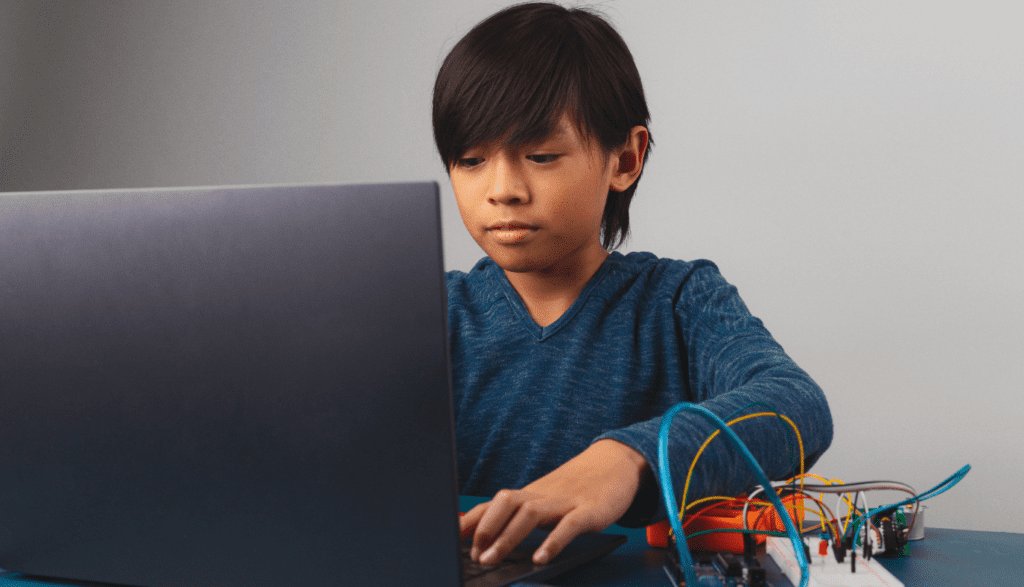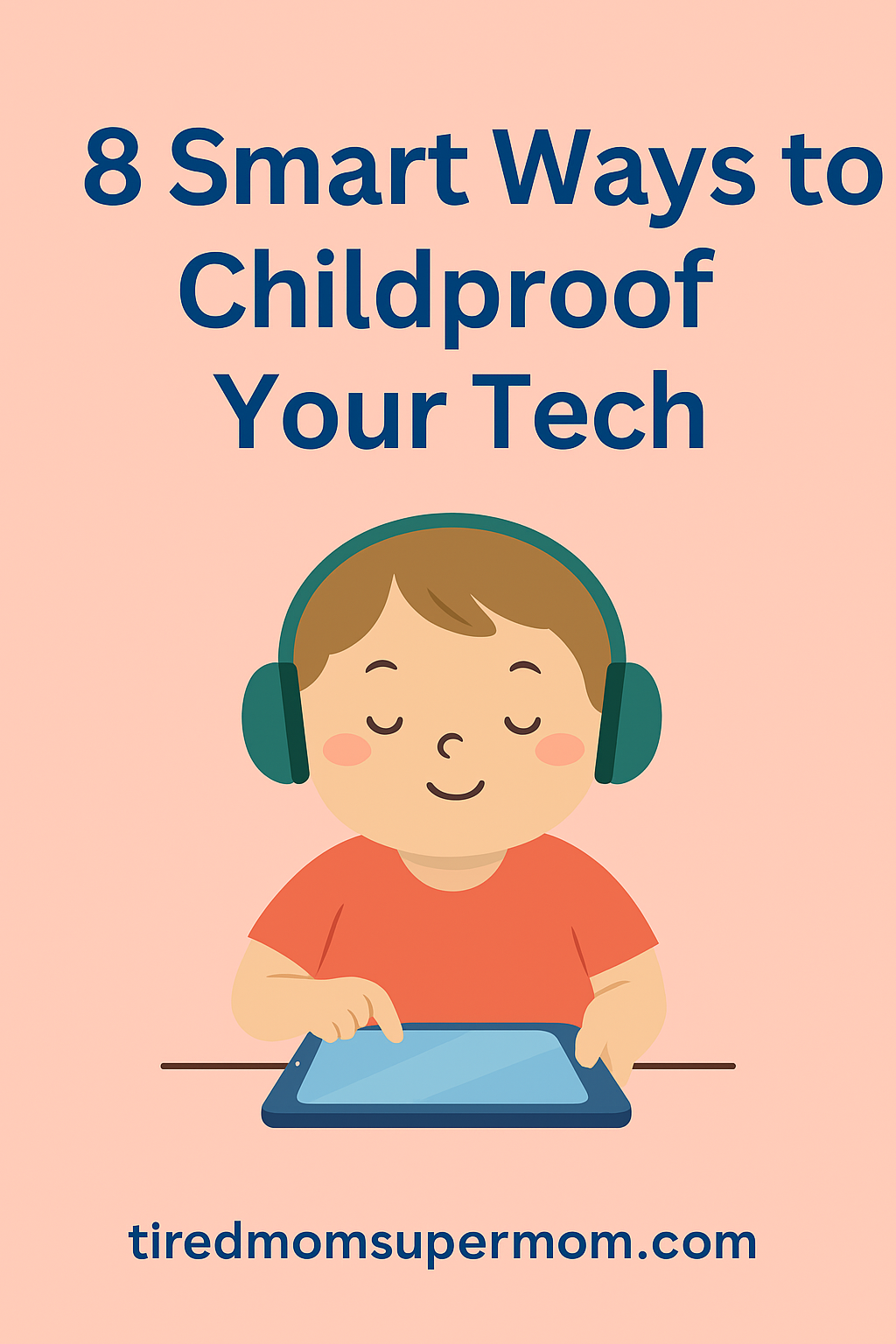8 Genius Hacks for Childproofing Technology at Home
As our lives become increasingly digital, childproofing technology is just as essential as covering outlets or locking up cleaning supplies.
Kids are drawn to smartphones, tablets, and smart TVs like moths to a flame—and without the right safeguards, your child could stumble upon inappropriate content, rack up in-app purchases, or even damage expensive devices.
This guide walks you through everything you need to know about childproofing technology at home—from screen-time boundaries to the best kid-safe accessories.
Whether your little one is a toddler tapping on your iPad or a preschooler exploring educational apps, these practical steps will help you create a safer, more mindful digital environment.
Heads up: This post may include affiliate links. As an Amazon Associate, I earn from qualifying purchases—at no extra cost to you. Full privacy policy and disclosure here.
Why Childproofing Technology Is Non-Negotiable
We lock medicine cabinets and install baby gates, but often forget that technology poses real risks too. From accidental online shopping sprees to screen-induced tantrums, unmonitored tech can lead to emotional, financial, and behavioral concerns.
Here’s why childproofing technology is a must:
- Privacy and safety: Children can click on ads or give away personal info unknowingly.
- Content exposure: Kids may accidentally land on violent or inappropriate videos.
- Device damage: Tablets, remotes, and phones aren’t built for toddler handling.
- Overstimulation: Too much screen time impacts mood, attention span, and sleep.

1. Start With Screen Time Limits
One of the most effective ways to protect kids is by limiting screen time. According to the American Academy of Pediatrics, kids under 5 should have no more than 1 hour of screen time per day.
Use built-in tools like:
- Apple’s Screen Time (iOS)
- Google Family Link (Android)
- Amazon’s FreeTime for Kindle and Fire Tablets
🧠 Looking for strategies to create better screen boundaries? Check out how to cap kids’ screen time to 45 minutes with practical tips that actually work.
2. Enable Parental Controls on All Devices
From YouTube to Netflix, most platforms offer robust parental controls. These settings help you:
- Block explicit content
- Restrict downloads and purchases
- Set daily usage schedules
Start with:
3. Use Tech-Safe Accessories (and Protect Your Investment)
Let’s be honest—toddlers are not gentle users. From sticky fingers to sudden drops, investing in kid-friendly accessories helps protect your devices and your sanity.
🛒 Some Amazon favorites with affiliate links (ID: tmsp29-20):
- HDE Kids Case for iPad – Lightweight, shockproof, and easy for little hands to grip.
- Blue Light Blocking Glasses for Kids – Help reduce eye strain during digital use.
- Tablet Stand with Adjustable Height – Prevent neck strain and allow hands-free learning.
- Outlet Covers with Cord Shortener – Essential if your devices are near cords or chargers.
- Kid-Proof Bluetooth Headphones – Volume-limiting and wireless for safer listening.
4. Create Tech-Free Zones
Designating certain parts of the home as tech-free zones sets physical boundaries that reinforce screen limits.
Great places to start:
- The dinner table
- Bedrooms (especially for sleep hygiene)
- The car (unless using educational content like road trip activities for kids)
Add a small basket for tech items and establish “device drop” routines.
5. Choose Apps and Shows Wisely
If your kids do use screens, choose low-stimulation, educational content that supports their development.
Try:
- PBS Kids Games App
- Khan Academy Kids
- Noggin (Nick Jr.)
For streaming, see this list of 24 best low-stimulation shows for toddlers.
🎯 Pro tip: Avoid autoplay features. They keep kids hooked and reduce their ability to transition away from the screen.
6. Structure Their Day to Minimize Tech Reliance
Kids thrive on structure, and screen time is much easier to manage when built into a predictable schedule.
Use your daily rhythm to slot in times for:
- Active play
- Outdoor exploration
- Meals and chores
- Creative time (arts, water play, problem-solving)
💡 Need help creating structure? Here’s how to structure your toddler’s day to reduce screen meltdowns.
7. Offer Screen-Free Alternatives
Sometimes, the best tech protection is distraction through connection. Here are a few screen-free activities that still feel engaging and fun:
- Easy problem-solving activities for toddlers
- Building blocks or puzzles
- Sensory bins and exciting bath activities for toddlers
- Listening to audiobooks or podcasts
8. Talk About Digital Safety—Early and Often
Even toddlers can begin to understand boundaries around technology. Use simple language and real-life examples to explain:
- Why certain websites are off-limits
- That it’s okay to ask questions if something feels “weird”
- How to be gentle with screens and cords
As kids grow older, introduce conversations about social media, privacy, and cyberbullying.

Frequently Asked Questions (FAQ)
What’s the best way to childproof a tablet or smartphone?
Use a combination of built-in parental controls, a durable childproof case, and clear screen time expectations. Lock down settings like in-app purchases and app downloads to minimize accidental interactions.
How do I stop my child from accidentally buying things online?
Go into your device’s settings and disable in-app purchases. Most devices let you require a password or biometric confirmation before completing purchases.
Are there childproof browsers or search engines for kids?
Yes! Try Kiddle, KidRex, or Safe Search Kids, all of which offer filtered results and a more age-appropriate browsing experience.
What’s a safe amount of screen time for toddlers?
Experts recommend no more than 1 hour of high-quality screen time per day for children aged 2–5. For babies under 18 months, screen time should be limited to video chatting with loved ones.
What should I do if my child has a meltdown after screen time ends?
Use consistent transitions like timers or visual cues. You can also ease the shift by offering a hands-on activity like water play or story time to redirect their focus.
Final Thoughts on Childproofing Technology
Childproofing technology is about more than just protecting your gadgets — it’s about creating a digital environment where your child can explore, learn, and grow safely.
By setting clear boundaries, using the right tools, and staying involved in your child’s tech habits, you’re laying the foundation for a healthier relationship with screens.
With a little planning and the right accessories, you can enjoy the benefits of modern tech without the stress.

